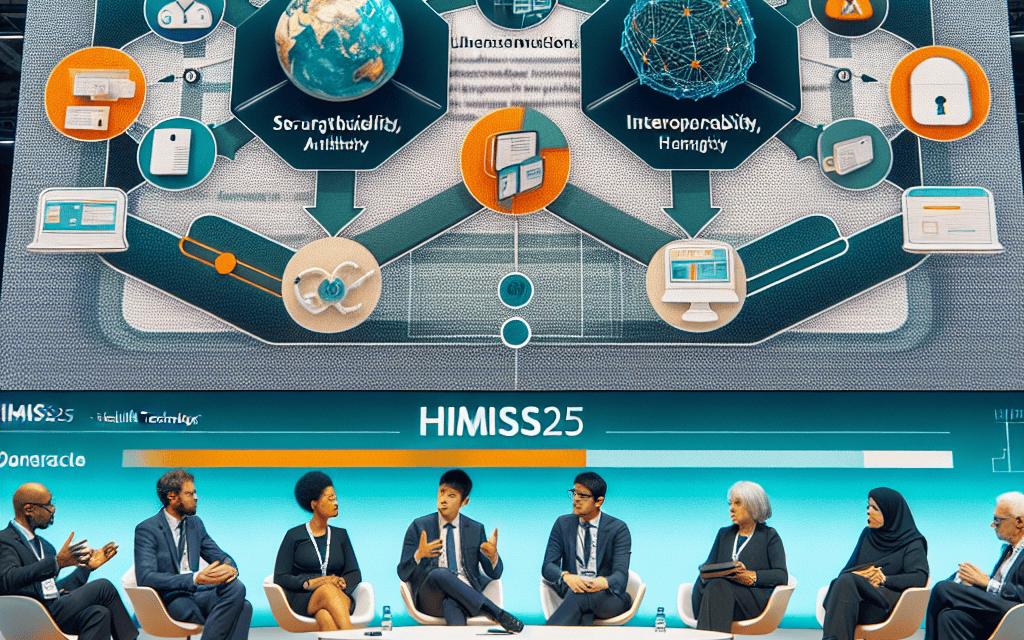Security Mindset Essential for Interoperability, HIMSS25 Panel Asserts
The healthcare industry is undergoing a significant transformation, driven by technological advancements and the increasing need for interoperability among various systems. As healthcare organizations strive to improve patient care and streamline operations, the importance of a robust security mindset cannot be overstated. At the HIMSS25 conference, a panel of experts emphasized that a security-first approach is not just an option but a necessity for achieving true interoperability in healthcare. This article delves into the critical aspects of this security mindset, exploring its implications for interoperability, the challenges faced, and strategies for implementation.
The Importance of Interoperability in Healthcare
Interoperability in healthcare refers to the ability of different information systems, devices, and applications to communicate and exchange data effectively. This capability is essential for enhancing patient care, improving operational efficiency, and enabling data-driven decision-making. The HIMSS25 panel highlighted several key reasons why interoperability is crucial in the healthcare landscape:
- Improved Patient Outcomes: Interoperability allows healthcare providers to access comprehensive patient information, leading to better diagnosis and treatment plans.
- Enhanced Care Coordination: Seamless data exchange among providers ensures that all members of a patient’s care team are informed and aligned, reducing the risk of errors.
- Operational Efficiency: Interoperable systems streamline workflows, reduce administrative burdens, and minimize duplication of tests and procedures.
- Data-Driven Insights: Access to integrated data enables healthcare organizations to analyze trends, improve population health management, and support research initiatives.
- Regulatory Compliance: Many regulations, such as the 21st Century Cures Act, mandate interoperability, making it essential for organizations to comply with legal requirements.
Despite these benefits, achieving interoperability remains a significant challenge due to various factors, including disparate systems, data silos, and varying standards. The panel emphasized that a security mindset is vital to overcoming these obstacles and ensuring that data exchange is both effective and secure.
The Role of Security in Interoperability
Security is a fundamental component of interoperability. As healthcare organizations share sensitive patient information across different platforms, the risk of data breaches and cyberattacks increases. The HIMSS25 panel underscored the following aspects of security that are essential for fostering interoperability:
- Data Protection: Ensuring that patient data is encrypted and protected during transmission and storage is critical to maintaining confidentiality and trust.
- Access Control: Implementing robust access controls ensures that only authorized personnel can access sensitive information, reducing the risk of insider threats.
- Compliance with Standards: Adhering to industry standards and regulations, such as HIPAA, is essential for safeguarding patient data and ensuring interoperability.
- Incident Response: Developing a comprehensive incident response plan enables organizations to quickly address security breaches and minimize their impact.
- Continuous Monitoring: Regularly monitoring systems for vulnerabilities and threats is crucial for maintaining a secure interoperable environment.
By prioritizing security, healthcare organizations can build a foundation of trust that encourages collaboration and data sharing among various stakeholders. The panel emphasized that a proactive security mindset is essential for creating an interoperable ecosystem that benefits patients and providers alike.
Challenges to Achieving a Security Mindset
While the importance of a security mindset is clear, several challenges hinder its implementation in the healthcare sector. The HIMSS25 panel identified the following key obstacles:
- Legacy Systems: Many healthcare organizations still rely on outdated systems that lack modern security features, making them vulnerable to attacks.
- Resource Constraints: Limited budgets and staffing can impede organizations’ ability to invest in security measures and training.
- Complex Regulatory Landscape: Navigating the myriad of regulations and standards can be overwhelming, leading to compliance challenges.
- Cultural Resistance: A lack of awareness or understanding of security issues among staff can result in resistance to adopting a security-first approach.
- Rapid Technological Change: The fast pace of technological advancements can outstrip organizations’ ability to implement adequate security measures.
Addressing these challenges requires a concerted effort from healthcare organizations, policymakers, and technology vendors. The panel emphasized the need for collaboration and knowledge sharing to develop effective strategies for overcoming these barriers.
Strategies for Implementing a Security Mindset
To cultivate a security mindset essential for interoperability, healthcare organizations must adopt a multi-faceted approach. The HIMSS25 panel proposed several strategies for implementation:
- Leadership Commitment: Leadership must prioritize security and allocate resources to develop and maintain a robust security framework.
- Employee Training: Regular training programs should be established to educate staff about security best practices and the importance of safeguarding patient data.
- Risk Assessment: Conducting regular risk assessments helps organizations identify vulnerabilities and develop strategies to mitigate them.
- Collaboration with Vendors: Engaging with technology vendors to ensure that security is integrated into all systems and applications is crucial for maintaining a secure environment.
- Adopting Best Practices: Implementing industry best practices, such as the NIST Cybersecurity Framework, can provide a structured approach to managing security risks.
By adopting these strategies, healthcare organizations can create a culture of security that permeates every aspect of their operations, ultimately facilitating interoperability and improving patient care.
Case Studies: Successful Implementation of a Security Mindset
Several healthcare organizations have successfully implemented a security mindset that has enhanced their interoperability efforts. The HIMSS25 panel shared notable case studies that illustrate the positive impact of prioritizing security:
- Case Study 1: Mayo Clinic – Mayo Clinic has invested heavily in cybersecurity measures, including advanced threat detection systems and employee training programs. As a result, they have successfully integrated their electronic health record (EHR) systems across multiple locations while maintaining high levels of data security.
- Case Study 2: Intermountain Healthcare – Intermountain Healthcare adopted a comprehensive security framework that includes regular risk assessments and incident response planning. Their proactive approach has enabled them to share patient data securely with external partners, improving care coordination and patient outcomes.
- Case Study 3: Partners HealthCare – Partners HealthCare implemented a robust access control system that ensures only authorized personnel can access sensitive patient information. This initiative has significantly reduced the risk of data breaches while facilitating seamless data exchange among providers.
- Case Study 4: Cleveland Clinic – Cleveland Clinic has embraced a culture of security by integrating cybersecurity training into their onboarding process. This commitment to education has empowered employees to recognize and respond to potential security threats, enhancing the organization’s overall security posture.
- Case Study 5: Ascension Health – Ascension Health has developed a comprehensive incident response plan that includes regular drills and simulations. This proactive approach has enabled them to respond quickly to security incidents, minimizing their impact on patient care and operations.
These case studies demonstrate that a security mindset is not only achievable but also essential for fostering interoperability in healthcare. By learning from these examples, other organizations can develop their strategies for implementing a security-first approach.
Conclusion: The Path Forward for Interoperability and Security
The HIMSS25 panel’s assertion that a security mindset is essential for interoperability resonates deeply within the healthcare industry. As organizations strive to improve patient care and operational efficiency through data sharing, the importance of robust security measures cannot be overlooked. By prioritizing security, healthcare organizations can build trust among stakeholders, facilitate seamless data exchange, and ultimately enhance patient outcomes.
As the healthcare landscape continues to evolve, it is imperative for organizations to address the challenges associated with implementing a security mindset. By adopting effective strategies, learning from successful case studies, and fostering a culture of security, healthcare organizations can pave the way for a more interoperable future.
In summary, the key takeaways from this discussion include:
- The critical role of interoperability in improving patient care and operational efficiency.
- The necessity of a security mindset to protect sensitive patient data and facilitate data exchange.
- The challenges that hinder the implementation of a security-first approach in healthcare.
- Strategies for cultivating a security mindset within healthcare organizations.
- Real-world examples of successful implementation that can serve as models for others.
As we move forward, it is essential for all stakeholders in the healthcare ecosystem to collaborate and prioritize security in their interoperability efforts. Only then can we unlock the full potential of technology to improve patient care and outcomes.





